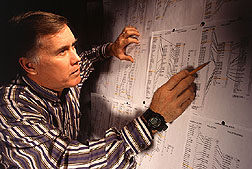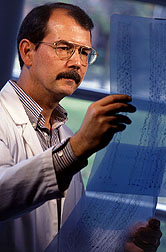There's Treasure in the Soybean Genome Map
|
|
The soybean has three fewer pairs of chromosomes and about 1.7 billion fewer pieces of DNA units than humans. But Perry B. Cregan has shown that the same scientific tools can be used to draw the map of both the soybean and human genomes.
Cregan is a plant geneticist with the Agricultural Research Service in Beltsville, Maryland. The United Soybean Board has given him and colleagues elsewhere in the country more than $1 million to construct a map of the soybean genome using a technique from the human genome project called SSRs—simple sequence repeats.
This approach allows Cregan to look at the smallest pieces of DNA in each of the soybean's 20 pairs of chromosomes that contain a total of 1.3 billion bases, or units. Each base is represented by a single letter of the DNA alphabet: A-G-C-T, for adenine, guanine, cystosine, and thymine.
Cregan and colleagues use SSRs to find unique variations in these pieces that can serve as markers for nearby genes. With earlier technology from the human genome project, they mapped the broad outline of all 20 pairs of the soybean's chromosomes.
So far, they've found more than 700 SSR markers from within these 20 chromosome pairs. Now they're filling in the details—one unit at a time—with a new type of DNA marker, SNP (for single nucleotide polymorphism). There are an average of 65 million bases per chromosome, says Cregan. "Ideally, we'd like to have an SNP marker every 100,000 to 250,000 bases." SNP has greatly increased the rate of DNA marker discovery.
Cregan is actually working with three other teams of scientists, each of which has a different genetic map because each uses different soybean varieties. And a fourth map is in the offing.
Cregan's ARS colleague, Randy C. Shoemaker, is leading a team of researchers that has developed a map at Iowa State University. Researchers at the University of Nebraska at Lincoln and the University of Utah at Salt Lake City have the other two maps.
The soybean mapping is part of a national public-sector initiative to map the genomes of various crops and publicly disseminate the results. To give the public access, Cregan will e-mail the genetic sequences of the 600-plus SSR markers he has found to any researcher who requests them.
The sequences are also available on SoyBase, the USDA/ARS Soybean Genome Database developed under Shoemaker's leadership. To access them on the World Wide Web, go to http://129.186.26.94/
Why would the United Soybean Board spend a million dollars to draw a map of the soybean genome? One reason is a projected additional 220 million bushels of soybeans a year for American farmers to sell on the domestic and international markets. That's the number of bushels robbed each year by just one soybean pest, the soybean cyst nematode.
Cregan's goal and that of a number of other soybean researchers is to identify genes that will provide resistance to the soybean cyst nematode so the resistance can be bred into commercial soybean varieties. Cregan has completed the development of mapping markers for the first two of the four genes he thinks are responsible. He's continuing work with colleagues at the University of Minnesota to find markers for the remaining two resistance genes.
Potential gains are huge for American farmers. The extra 220 million bushels is just for starters. Throw in another few hundred million bushels for other pests the soybean might also resist, were a complete genome map available to plant breeders. And yet another 200 million bushels or so could be harvested, were genes found to raise soybean yields 2 or 3 bushels an acre over America's typical yearly plantings of 75 million acres.
Cregan and his colleagues are hoping to find DNA fragments from the wild ancestor of soybean that could induce such a yield increase in commercial soybeans. He and the Nebraska team have developed over 300 lines of soybeans that have one-eighth of their genomes replaced by DNA fragments from the wild ancestor of soybeans.
"If you could see the scrawny vine a wild soybean is, with seed pods that hold seeds not much bigger than poppy seeds, you'd realize how unlikely it seems that genetic material from the wild soybean could be used to improve the beefy soybeans on the market today," says Cregan. "Without DNA markers, it would be impossible to find just the right wild soybean DNA fragments. But this SSR genome map allows us to do a unit-by-unit search for genetic benefits. It is what gives our breeding efforts a reasonable probability of success."
And the maps will make breeding easier and quicker. No longer will breeders have to grow plants and expose them to insects or plant diseases to find the resistant ones, says Cregan. "They can use the map markers to identify the resistant plants and only continue breeding the plants that have the genes they want." — By Don Comis, Agricultural Research Service Information Staff.
|
|
This research is part of Plant, Microbial, and Insect Germplasm Conservation and Development, an ARS National Program described on the World Wide Web at http://www.nps.ars.usda.gov/programs/301s2.htm.
Perry B. Cregan is at the USDA-ARS Soybean and Alfalfa Research Laboratory, Bldg. 006, 10300 Baltimore Ave., Beltsville, MD 20705-2350; phone (301) 504-5070, fax (301) 504-5728.
Public Soybean EST Project
Time-lapse photography reveals the beauty of a blooming flower in a dynamic way that the human eye cannot perceive in real time.
Similarly, Agricultural Research Service scientists are taking "snapshots" of soybean genes at different stages of genetic expression to capture a similar picture. The objective is to identify genes in the soybean genome that are turned on, or expressed, at different stages of plant development.
This approach will advance the scientists' ability to detect the differences in a gene that is inactive versus when it is expressed. Results of the studies will be made available worldwide via the Internet.
In the Public Soybean EST (Expressed Sequence Tag) Project, scientists will attempt to identify all 80,000 genes in the soybean plant while they are turned on.
ARS geneticist Randy C. Shoemaker in Ames, Iowa, is the principal investigator on the EST project. Lila O. Vodkin at the University of Illinois, Paul Keim at Northern Arizona University, Ernest Retzel at the University of Minnesota, and scientists at Washington University are co-investigators.
"We have two goals," says Shoemaker, who is based at ARS' Corn Insects and Crop Genetics Research Laboratory in Ames. "One is to identify the structure of the soybean genome and tag, or identify, the genes that make up that structure. Second, we will identify the function of those genes and what they tell the plant to do."
A functional genetic map will give researchers more information on specific traits and how to use them to develop new varieties.—By Dawn Lyons-Johnson, formerly with ARS.
Randy C. Shoemaker is at the USDA-ARS Corn Insects and Crop Genetics Research Laboratory, 1575 Agronomy Bldg., Iowa State University, Ames, IA 50011; phone (515) 294-6233, fax (515) 294-2299.
"There's Treasure in the Soybean Genome Map" was published in the February 1999 issue of Agricultural Research magazine.









